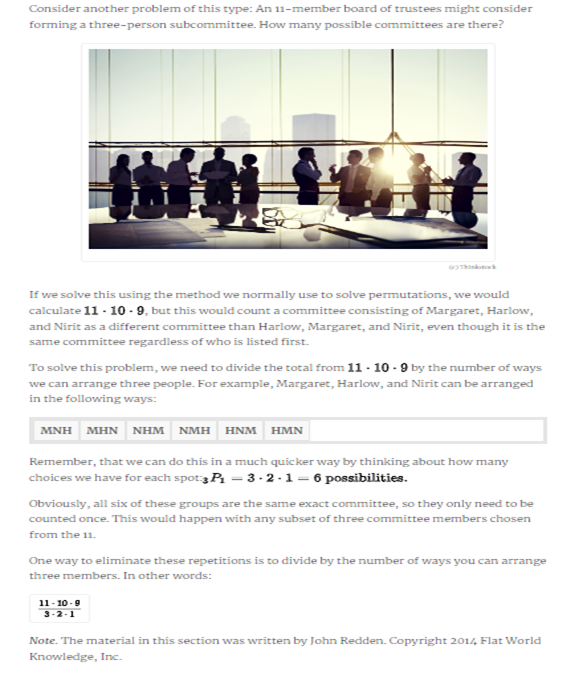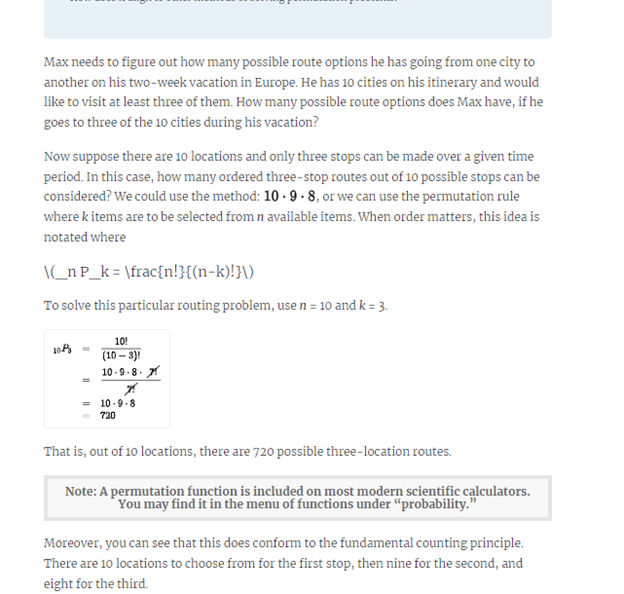Learning Activities titled “A Formula for Permutations” and “A Formula for Combinations.” (below) Explain how the Fundamental Counting Principle is used each time the Permutation Formula (nPr) or the Combination Formula (nCr) is applied. Would these be considered independent or dependent events? Or, is it inappropriate to be concerned about whether it is independent/dependent? Explain your thinking on the question.
Learning Activities titled “A Formula for Permutations” and “A Formula for Combinations.” (below) Explain how the Fundamental Counting Principle is used each time the Permutation Formula (nPr) or the Combination Formula (nCr) is applied. Would these be considered independent or dependent events? Or, is it inappropriate to be concerned about whether it is independent/dependent? Explain your thinking on the question.
Algebra: Structure And Method, Book 1
(REV)00th Edition
ISBN:9780395977224
Author:Richard G. Brown, Mary P. Dolciani, Robert H. Sorgenfrey, William L. Cole
Publisher:Richard G. Brown, Mary P. Dolciani, Robert H. Sorgenfrey, William L. Cole
Chapter4: Polynomials
Section4.1: Exponents
Problem 2CE
Related questions
Question
Learning Activities titled “A Formula for Permutations” and “A Formula for Combinations.” (below) Explain how the Fundamental Counting Principle is used each time the Permutation Formula (nPr) or the Combination Formula (nCr) is applied. Would these be considered independent or dependent events? Or, is it inappropriate to be concerned about whether it is independent/dependent? Explain your thinking on the question.

Transcribed Image Text:Consider another problem of this type: An 11-member board of trustees might consider
forming a three-person subcommittee. How many possible committees are there?
43
If we solve this using the method we normally use to solve permutations, we would
calculate 11.10-9, but this would count a committee consisting of Margaret, Harlow,
and Nirit as a different committee than Harlow, Margaret, and Nirit, even though it is the
same committee regardless of who is listed first.
To solve this problem, we need to divide the total from 11-10-9 by the number of ways
we can arrange three people. For example, Margaret, Harlow, and Nirit can be arranged
in the following ways:
MNH MHN NHM NMH HNM HMN
Remember, that we can do this in a much quicker way by thinking about how many
choices we have for each spot:3 P₁-3-2-1-6 possibilities.
Obviously, all six of these groups are the same exact committee, so they only need to be
counted once. This would happen with any subset of three committee members chosen
from the 11.
One way to eliminate these repetitions is to divide by the number of ways you can arrange
three members. In other words:
11-10-9
3-2-1
Note. The material in this section was written by John Redden. Copyright 2014 Flat World
Knowledge, Inc.

Transcribed Image Text:Max needs to figure out how many possible route options he has going from one city to
another on his two-week vacation in Europe. He has 10 cities on his itinerary and would
like to visit at least three of them. How many possible route options does Max have, if he
goes to three of the 10 cities during his vacation?
Now suppose there are 10 locations and only three stops can be made over a given time
period. In this case, how many ordered three-stop routes out of 10 possible stops can be
considered? We could use the method: 10-9-8, or we can use the permutation rule
where k items are to be selected from n available items. When order matters, this idea is
notated where
\(_n P_k= \frac{n!}{[(n-k)!}\)
To solve this particular routing problem, use n = 10 and k = 3.
10.P
10!
(10-3)!
10-9-8-7
X
= 10.9.8
720
That is, out of 10 locations, there are 720 possible three-location routes.
Note: A permutation function is included on most modern scientific calculators.
You may find it in the menu of functions under "probability."
Moreover, you can see that this does conform to the fundamental counting principle.
There are 10 locations to choose from for the first stop, then nine for the second, and
eight for the third.
Expert Solution
This question has been solved!
Explore an expertly crafted, step-by-step solution for a thorough understanding of key concepts.
This is a popular solution!
Trending now
This is a popular solution!
Step by step
Solved in 3 steps

Recommended textbooks for you

Algebra: Structure And Method, Book 1
Algebra
ISBN:
9780395977224
Author:
Richard G. Brown, Mary P. Dolciani, Robert H. Sorgenfrey, William L. Cole
Publisher:
McDougal Littell


Algebra & Trigonometry with Analytic Geometry
Algebra
ISBN:
9781133382119
Author:
Swokowski
Publisher:
Cengage

Algebra: Structure And Method, Book 1
Algebra
ISBN:
9780395977224
Author:
Richard G. Brown, Mary P. Dolciani, Robert H. Sorgenfrey, William L. Cole
Publisher:
McDougal Littell


Algebra & Trigonometry with Analytic Geometry
Algebra
ISBN:
9781133382119
Author:
Swokowski
Publisher:
Cengage